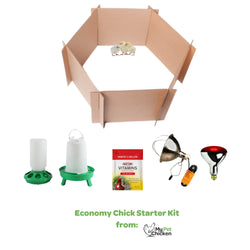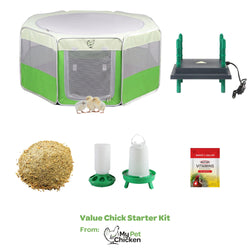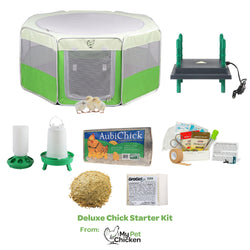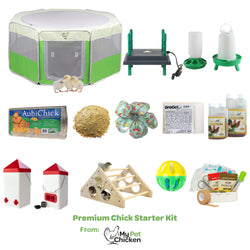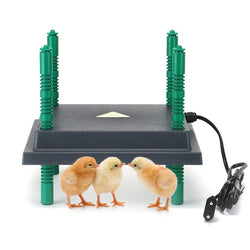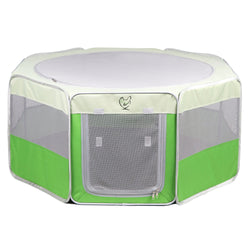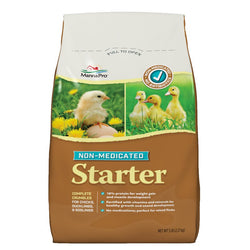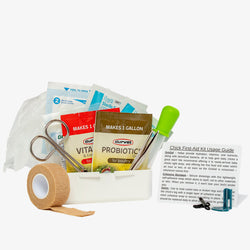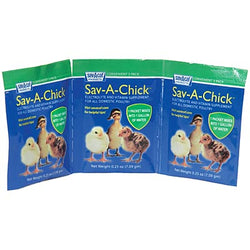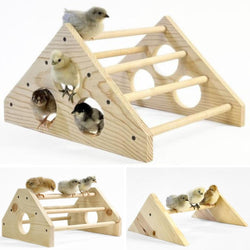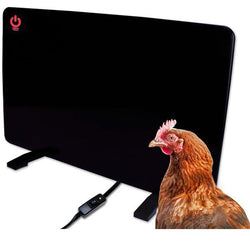All about Egg Binding
Back to blog
Egg binding is exactly what it sounds like: a poor hen has a egg "bound" inside of her and won't come out. That must make her feel miserable! So she'll sit down and fluff out her feathers, hesitant to move (who can blame her?). Egg binding is very common and though potentially fatal, thankfully, in many cases, it can be treated. Read on to find out more:
Egg binding Also called
Eggbound hen, stuck egg, bound egg, obstructed vent
Prevalence
Common in some breeds and crosses, especially those prone to fatness (such as meat breeds)
Signs
General signs -
Lack of appetite, lethargy, huddling with fluffed up feathers, cessation in laying, distended abdomen.
Cardinal or diagnostic signs -
Straining to lay an egg, paired with occasional cloaca protruding from the vent. This will eventually be fatal, because additional eggs will build up behind the blockage, unable to pass. Additionally, if an egg breaks inside her, the hen may be subject to septicemia.
Cause/s
This typically happens when an egg is too large to pass, often in a young pullet producing eggs too large for her age. (Young birds produce smaller eggs than their breed is capable of at first; the eggs get gradually larger as her reproductive tract relaxes.) Can also be caused by nutritional imbalances--feeding too many treats can cause the problem, as it can throw off the nutrition ratios in their balanced feed. For instance, not enough calcium can cause the problem, or not enough magnesium or vitamin D (which help the body to process calcium) can also cause the problem. Muscle weakness in the reproductive tract can also be caused by inadequate magnesium.
Communicability
Egg binding itself is not contagious, but the underlying nutritional problems can be. If it�s an issue of the breed being prone to binding (such as commercial "meat" breeds, of course you may also see several hens with this issue.
Communicability to humans
No.
Incubation period
N/A
Latent
No. This is not communicable, so birds do not become carriers. However, a bird may have chronic problems with egg binding.
Endemic
This can happen in any environment.
Home treatment and/or prevention
Prevention: Provide proper nutrition for your birds. If possible, allow them to supplement their diets by foraging in yard or pasture. Access to a yard also allows them exercise which can reduce egg binding problems related to obesity. Avoid breeds and crosses prone to obesity, such as Rock-Cornish crosses. If you see portions of your hen�s cloaca protruding through her vent (vent prolapse), please be sure to separate her, as she may be a target of pecking/cannibalization.
Treatment: If your hen is egg bound and you can feel the egg in her abdomen close to the vent, don a latex or non-latex glove, and carefully lubricate the vent to help the egg pass. Be sure not to break it if possible--sharp edges inside her are dangerous. A warm bath can help her relax; one customer with experience treating songbirds with this condition suggested a warm bath in chamomile tea, because the scent promotes relaxation (although be warned that white or light feathers may be stained yellow). When the egg passes, please be sure to double-check that your hens are receiving a proper diet and plenty of room to exercise. If you cannot get the egg to pass--or if the egg accidentally breaks--consult a veterinarian.
Veterinary care
A veterinarian can help your hen pass the egg, and may be able to identify the cause of the condition (breed-related, nutritional deficiencies, obesity, etc.). If the egg will not pass as-is, the vet can safely break the egg inside and remove sharp pieces without hurting your hen.
Recovery
If she passes the egg safely, recovery from an egg obstruction can be quick. If your hen had an egg break inside her, your vet may prescribe antibiotics to be safe. If a prolapse has occurred, keep her separate until she is fully recovered and no longer a target. Preparation H may be of use in cases where the prolapse is small and no further injury was visited on her.
Other conditions, illnesses and/or diseases with similar signs:
Broodiness shares some of the same signs as egg binding: fluffed up feathers, a drop in appetite, cessation in laying, spending time in the nest, etc., so these signs of broodiness may be mistaken for egg binding.
Egg binding Also called
Eggbound hen, stuck egg, bound egg, obstructed vent
Prevalence
Common in some breeds and crosses, especially those prone to fatness (such as meat breeds)
Signs
General signs -
Lack of appetite, lethargy, huddling with fluffed up feathers, cessation in laying, distended abdomen.
Cardinal or diagnostic signs -
Straining to lay an egg, paired with occasional cloaca protruding from the vent. This will eventually be fatal, because additional eggs will build up behind the blockage, unable to pass. Additionally, if an egg breaks inside her, the hen may be subject to septicemia.
Cause/s
This typically happens when an egg is too large to pass, often in a young pullet producing eggs too large for her age. (Young birds produce smaller eggs than their breed is capable of at first; the eggs get gradually larger as her reproductive tract relaxes.) Can also be caused by nutritional imbalances--feeding too many treats can cause the problem, as it can throw off the nutrition ratios in their balanced feed. For instance, not enough calcium can cause the problem, or not enough magnesium or vitamin D (which help the body to process calcium) can also cause the problem. Muscle weakness in the reproductive tract can also be caused by inadequate magnesium.
Communicability
Egg binding itself is not contagious, but the underlying nutritional problems can be. If it�s an issue of the breed being prone to binding (such as commercial "meat" breeds, of course you may also see several hens with this issue.
Communicability to humans
No.
Incubation period
N/A
Latent
No. This is not communicable, so birds do not become carriers. However, a bird may have chronic problems with egg binding.
Endemic
This can happen in any environment.
Home treatment and/or prevention
Prevention: Provide proper nutrition for your birds. If possible, allow them to supplement their diets by foraging in yard or pasture. Access to a yard also allows them exercise which can reduce egg binding problems related to obesity. Avoid breeds and crosses prone to obesity, such as Rock-Cornish crosses. If you see portions of your hen�s cloaca protruding through her vent (vent prolapse), please be sure to separate her, as she may be a target of pecking/cannibalization.
Treatment: If your hen is egg bound and you can feel the egg in her abdomen close to the vent, don a latex or non-latex glove, and carefully lubricate the vent to help the egg pass. Be sure not to break it if possible--sharp edges inside her are dangerous. A warm bath can help her relax; one customer with experience treating songbirds with this condition suggested a warm bath in chamomile tea, because the scent promotes relaxation (although be warned that white or light feathers may be stained yellow). When the egg passes, please be sure to double-check that your hens are receiving a proper diet and plenty of room to exercise. If you cannot get the egg to pass--or if the egg accidentally breaks--consult a veterinarian.
Veterinary care
A veterinarian can help your hen pass the egg, and may be able to identify the cause of the condition (breed-related, nutritional deficiencies, obesity, etc.). If the egg will not pass as-is, the vet can safely break the egg inside and remove sharp pieces without hurting your hen.
Recovery
If she passes the egg safely, recovery from an egg obstruction can be quick. If your hen had an egg break inside her, your vet may prescribe antibiotics to be safe. If a prolapse has occurred, keep her separate until she is fully recovered and no longer a target. Preparation H may be of use in cases where the prolapse is small and no further injury was visited on her.
Other conditions, illnesses and/or diseases with similar signs:
Broodiness shares some of the same signs as egg binding: fluffed up feathers, a drop in appetite, cessation in laying, spending time in the nest, etc., so these signs of broodiness may be mistaken for egg binding.
